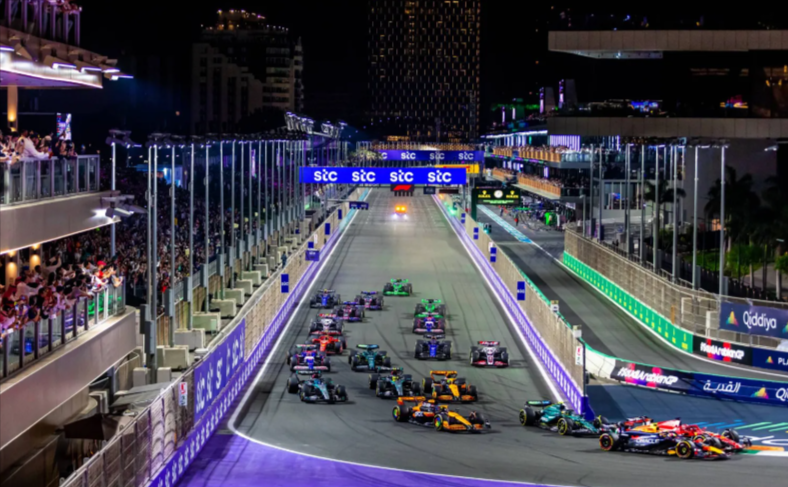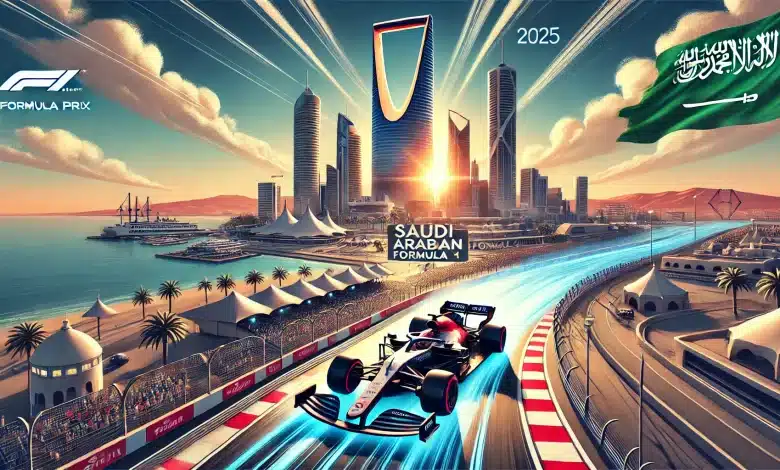
Jeddah, the Bride of the Red Sea, returns to the forefront this weekend, hosting the fifth edition of the Formula 1 Saudi Grand Prix. This year’s race, one of the world’s most prominent sporting events, will take place from the 18th to the 20th of this month, following the conclusion of the final round in Bahrain on Sunday.
Jeddah has created a creative landscape in the past four editions of this race, with the championship itself continuing to feature in the same venue that has held unforgettable memories for international stars, passionate fans, and local and international media outlets competing to attend and cover the race.
Since the launch of the first edition of Formula 1 in Jeddah in 2021, the Kingdom of Saudi Arabia has succeeded in consolidating its position as a pivotal destination in the world of motorsports. Hosting this race was not just a sporting event, but part of an ambitious national strategy aimed at developing the sports sector and strengthening the Kingdom’s global presence in various fields.
The Jeddah Corniche Circuit, home to this global race, has become one of the most prominent Formula 1 venues, having been constructed in a record-breaking seven months. Its unique design makes it one of the most competitive circuits in the world. It is the second-longest circuit in Formula 1 history, measuring 6.176 kilometers, and the fastest street circuit, with an average speed of 252.8 km/h. It features 27 corners and three DRS zones, providing speed enthusiasts with an exceptional and unforgettable experience. The most recent exciting event in Jeddah for the world’s most famous motor race was held amidst a remarkable global audience and extensive media participation, with more than 300 journalists from 41 different nationalities present, seeking to cover the latest news and highlights. The event also received extensive media coverage across more than 50 international television channels, in addition to the participation of 114 international media outlets and 28 local outlets last year, reflecting the renewed success of the major sporting event in the Kingdom.
On the world-class Jeddah Corniche Circuit, where speed meets excitement, champions have made history. Britain’s Lewis Hamilton won the first edition in the Kingdom, before Max Verstappen won the second edition. Sergio Perez then won the third edition, before Verstappen reclaimed his successes by winning the last edition, his fourth consecutive title in the Kingdom.
Before the start of the anticipated event, motorsports fans are anticipating the race’s historic events. This is the fifth consecutive edition hosted by the Kingdom, a preferred global destination for various sports in general, and motorsports in particular. This is in light of the Ministry of Sports’ ongoing efforts to achieve national goals, contribute to the development of the sports sector, and grow the national economy.
As one of the most advanced and innovative sports, Formula 1 continues to update its rules to keep pace with rapid changes in technology, safety, and fairness in competition. The organizing committee has announced a series of major rule changes for 2025 to make the sport safer, more exciting, and fairer.
In a move aimed at restructuring the competition and focusing on overall performance, the bonus point awarded to the driver who sets the fastest lap has been removed. This change reflects Formula 1’s desire to focus points on the overall race completion rather than awarding points based on individual performances. The rest of the points system will remain the same, with first place receiving 25 points, second place receiving 18 points, third place receiving 15 points, fourth place receiving 12 points, fifth place receiving 10 points, sixth place receiving 8 points, seventh place receiving 6 points, eighth place receiving 4 points, ninth place receiving 2 points, and tenth place receiving 1 point.
One of the most notable changes introduced to the Formula 1 rules for 2025 is the mandatory installation of cooling systems for drivers, especially in races held in hot environments. If the air temperature exceeds 31 degrees Celsius, a heat hazard will be declared. The new rules require teams to install cooling systems in all cars. With the aim of ensuring driver comfort and safety throughout the race, this modification will result in a 2 kg weight increase in testing and qualifying, and a 5 kg weight increase in races.
To ensure greater fairness in testing and qualifying among teams, Formula 1 has decided to impose restrictions on driver trials for older cars, in accordance with the new regulations. Drivers are only allowed to participate in four days of testing per year, with a maximum of 1,000 km. Teams are also allowed to run only one older-generation car during testing.
World stars are set for a fiery race weekend in Jeddah (Middle East)
Formula 1 is taking another step to enhance opportunities for young drivers and emerging talent by requiring teams to include rookie drivers in testing. Teams are now required to allow rookie drivers to participate at least four times during the season, with two per car.
These changes are part of Formula 1’s ongoing efforts to develop its racing and balance innovation, safety, and competitiveness. These steps will undoubtedly contribute to improving the championship, making it fairer and more balanced. It remains to be seen how these changes will impact the overall performance of teams and drivers in the 2025 season, but Formula 1 is sure to be even more exciting and innovative in the coming years.







